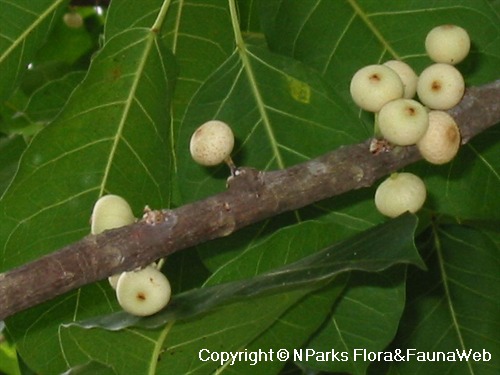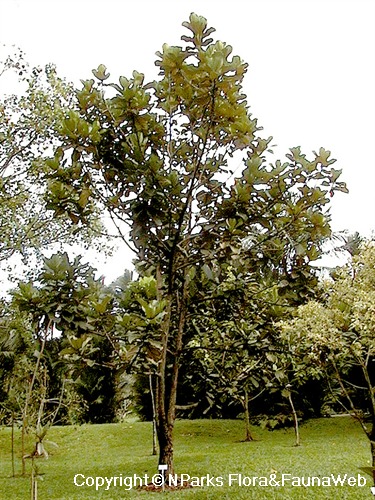
Back
Ficus pumila (Makino) Corner var. awkeotsang
| Family Name: | Moraceae |
| Synonyms: | Antiaris |
| Common Name: | Jelly Fig, 爱玉子 |
Name
Classifications and Characteristics
| Plant Division | Angiosperms (Flowering Seed Plants) (Dicotyledon) |
|---|---|
| Plant Growth Form | Climber, Shrub |
| Lifespan (in Singapore) | Perennial |
| Mode of Nutrition | Autotrophic |
Biogeography
| Native Distribution | Fujian, Taiwan, SE Zhejiang |
|---|---|
| Native Habitat | Terrestrial |
Description and Ethnobotany
| Growth Form | Climbing fig. |
|---|---|
| Foliage | The oblong to ovate leaves of Ficus pumila var. awkeotsang are 7-12 cm long and 3-5 cm wide. The underside of the leaf is covered with short, orangish brown hairs. |
| Flowers | The flowers are located inside of the figs. |
| Fruit | The fruits of Ficus pumila var. awkeotsang are cylindrical figs (6-8 cm long, 3-4 cm wide). The stalk which bear the fruit is about 1 cm long and thickly covered in hair. |
| Ethnobotanical Uses | Edible Plant Parts : Edible Fruits Food (Fruit or Vegetable): The seeds of Ficus pumila var. awkeotsang are used to make the ice jelly (Ai Yu Dong), which is popular in Taiwan and Southeast China. First, the fruit is dried inside out. The seeds are removed and rubbed together in mineral water until a gel exudes from the seeds which solidifies the water into jelly. After a couple days, the jelly will revert back to liquid. The jelly is typically eaten on ice with sweetened lime or lemon juice and fruit. |
Landscaping Features
| Desirable Plant Features | Ornamental Foliage, Ornamental Fruits |
|---|---|
| Landscape Uses | Parks & Gardens |
| Thematic Landscaping | Economic Garden |
Fauna, Pollination and Dispersal
| Pollination Method(s) | Biotic (Fauna) (Insects (Ant, Beetle, Fly, Thrip, Wasp)) |
|---|
Plant Care and Propagation
| Light Preference | Full Sun |
|---|---|
| Water Preference | Moderate Water |
| Plant Growth Rate | Fast |
| Rootzone Tolerance | Well-Drained Soils, Fertile Loamy Soils |
| Propagation Method | Seed, Stem Cutting |
Foliar
| Mature Foliage Colour(s) | Green |
|---|---|
| Mature Foliage Texture(s) | Leathery |
| Foliar Type | Simple / Unifoliate |
Fruit, Seed and Spore
| Mature Fruit Colour(s) | Green |
|---|---|
| Mature Fruit Texture(s) | Smooth |
| Mature Seed Colour(s) | Yellow / Golden |
| Mature Seed Texture(s) | Smooth |
| Seed Quantity Per Fruit | Numerous (>20) |
Image Repository
Others
| Master ID | 32817 |
|---|---|
| Species ID | 7230 |
| Flora Disclaimer | The information in this website has been compiled from reliable sources, such as reference works on medicinal plants. It is not a substitute for medical advice or treatment and NParks does not purport to provide any medical advice. Readers should always consult his/her physician before using or consuming a plant for medicinal purposes. |


.jpg)







